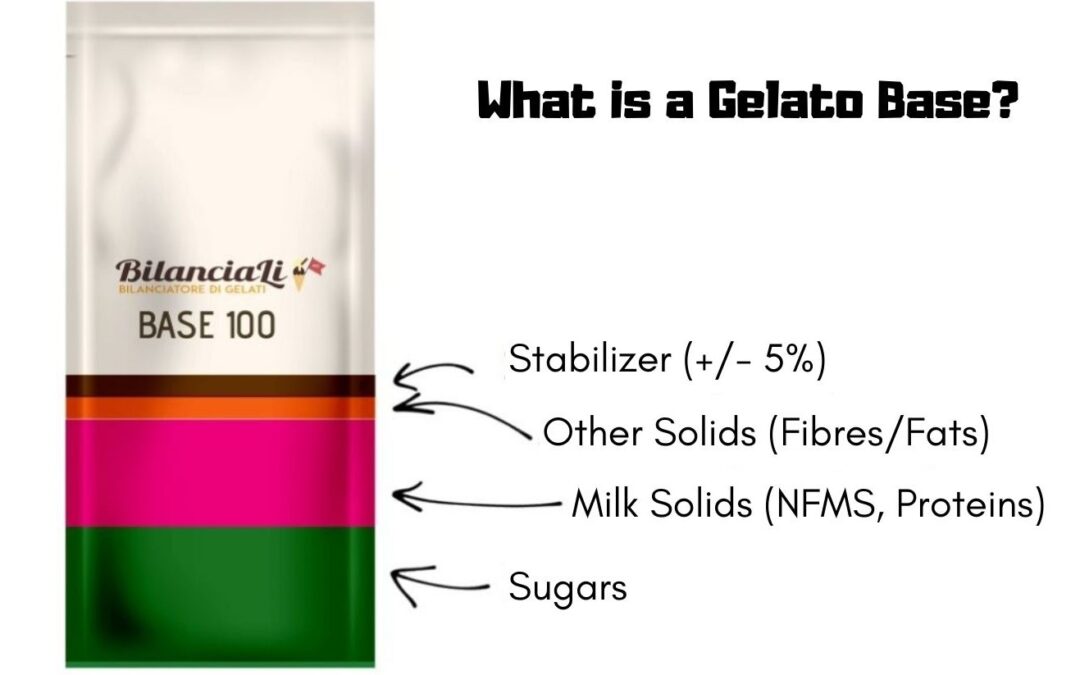Dear readers, today we continue our in-depth study of artisanal ice cream. After talking about how to balance neutrals in ice cream, we turn to Bases. Again thanks to the proven collaboration with Davide Frainetti, we delve into the world of artisanal ice cream and discover
- What is an ice cream base
- How you balance it with BilanciaLi
What are Ice Cream Bases?
In the professional field, we often hear about using Neutrals and Bases, but what are they actually?
For an ice cream to be well-structured and have good creaminess and stability, it needs to be composed of elements such as thickeners, emulsifiers, fiber, sugars, fats, proteins, etc.
When making ice cream at home, fewer elements are used since it is generally consumed in a short time. Artisanal ice cream that you buy in ice cream shops, however, is produced, displayed and sold over a longer time and therefore needs a different composition of raw materials and stabilizers.
Dosing a neutral is more difficult than dosing a base
Neutral has a low dosage, usually the between 3 percent and 5 percent of the mixture (so we are talking about a few grams). The rest of the mixture components are manually inserted by the ice cream maker.
A base, on the other hand, can be found in 50gr, 100gr, 200gr, 300gr and 400gr versions. A base is a pre-weighed mix composed of a core/neutral and “ballasted” with sugars, protein/milk powder, fiber and other solids from specialized industry companies.
The number in the base (base 50, base 100, base xxx) are nothing more than the grams of that mix to be used per liter of liquid in an ice cream recipe. A simple hypothetical recipe might be 1 liter of milk, 100gr base 100, 150gr sugar.
Dosing the neutral can be difficult for the simple fact that since it has a low dosage (2/5 g) and is composed mainly of thickeners, a wrong “weighing” can have lethal consequences for the ice cream. The margin of error decreases significantly when handling bases. Since they are also composed of other elements, their dosage is higher, and if you dropped by mistake a few extra grams into a mixture, the effects would probably be negligible.
Bases you can find on the market
The main bases are the 50gr and 100gr, which still leave the ice cream maker with the possibility of customizing the recipe through correction and addition of sugars, milk solids, and the other solids with liquids; with the high dosage bases such as the 200gr/300gr the recipe is almost “full” and the customizing possibilities are limited.
For example, if we took a 50gr base for creams, we would find a core + some sugars + low-fat milk, and to get to the right recipe balance percentage the other ingredients would have to be added by the ice cream maker.
Same goes for the base with 100gr dosage, already composed of some elements that perhaps the ice cream maker has difficulty finding and will go to complete the recipe with the other raw materials.
In a 300-gr base, we will already have a finished recipe at 30 percent on kg with all the elements and raw materials that make up the final ice cream and the ice cream maker will go on to add the liquid part and a small compensation of sugars.
Every ice cream maker has his or her own way of operating and based on practicality, availability of ingredients, and convenience of use will choose whether to opt for using a neutral or a base.
Each semi-finished goods company, has its own bases composed differently and marketed under their own names and different dosages. They differ in the type of end use: fruit, creams, lactose free, low sugar, vegan, palm oil free, with vegetable fats, etc.
Companies also produce custom bases for ice cream makers who have difficulty sourcing certain raw materials or who want to have their own base recipe already mixed in a bag.
Recipes of “standard” bases are never given away of course. In fact, to protect its trade secret, each company provides ingredient and balance parameters, but not the exact grams of ingredients that are inside. It would be like asking Ferrero for the exact recipe for the composition of Nutella.. everyone would reproduce it.
How to use a base?
For those who are not used to balancing, usually, bases are accompanied by a basic recipe book for successful “average” ice cream. Example: 1 liter of milk, 100gr base 100, 150gr sugar. It is not wrong and the ice cream will be ok, but these basic recipes do not always yield well in one’s own ice cream shop, so one needs ad hoc balancing act.
How to insert a base into the BilanciaLi balancer?
If you use BilanciaLi, CucinaLi’s Excel ice cream balancer, you can follow these instructions to insert any base into the balancer.
The BilanciaLi manual already shows how to enter foods into the ingredient table. Let’s see how to do it.
The Pro (or Gold) version(s) must be used for balancing against the liquids in the recipe. The Home version allows ingredients to be handled in the same way, but allows just the right balance of neutrals to the total weight of the ice cream.
Each base comes with balancing parameters, such as sugars, milk solids, fats, and other solids, so that an ice cream maker who balances their recipe knows how to best balance the ice cream for themselves.
In the data sheet that you can request from the person who supplied you with the base or separately, balancing parameters are stated as:
BASE 100 BILANCIALI
Ingredients: Skim Milk Powder, Dextrose, E410, E412, E471
Dosage: 100gr per liter of milk.
Balancing parameters:
| Sugars | Fats | N.F.M.S. | Other Solids | AFP |
| 40% | 1% | 52% | 7% | 76 |
AFP and SP are not always provided, and the parameters represented are those that are usually provided.
In BilanciaLi, all you have to do is go to the “Ingredients” tab and in the “Neutrals & Bases” section enter the base by reporting the same values in order in the table by assigning the name of the base. Once entered in the “Ingredients” tab, it will appear in the drop-down menu of the “Ice Creams” tab of the balancer in the “Neutrals and Stabilizers” section.

What to do if the AFP is not provided?
Look at the composition of the ingredients and the % of sugars listed.
- Is there only Dextrose? Then multiply the % of sugars by 1.9 (the AFP of dextrose).
- Is there only Sucrose? The AFP of sucrose is 1, so use the % of sugars for the AFP
- Are there different sugars? Average by looking at the ingredient table in the balancer and multiply by the % of sugars. So if there is Dextrose and Sucrose take 1.5 as the value and multiply by the % of sugars.
Achieving a proper balance based on one’s own tastes and needs is a practice that should be practiced by most artisan ice cream makers, where they themselves create their own ice cream with their own recipes.
Any other questions about the balancer?
Take a look at the user’s manual for BilanciaLi.
Ice Cream Insights & Online Courses
For a basic or advanced course on artisan ice cream (in italian), check out my online course offerings, also available in combination with BilanciaLi Pro & Home.
Do you like my recipes? Let’s stay in touch on #CucinaLiGram!
Don’t miss a single update and subscribe to my Telegram channel by clicking HERE (italian channel) also taking advantage of exclusive special offers on my cooking classes🙂

- What are ice cream bases and how to put them in the balancer? - 2 June 2023
- How to make high-protein ice cream at home? - 2 June 2023
- How to balance neutrals in ice cream - 2 June 2023


